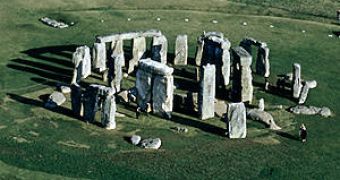Stonehenge represents one of the most beautiful prehistoric places worldwide, located on the plain of Salisbury, about 130 km (80 mi) off London. Why was it raised there?
The assembly was not formed just of the megaliths we see today, but it also comprised a circular fortification and an odd ring made of filled holes. The vertical and horizontal stones of Stonehenge look like having been made by a carpenter.
The oldest stage of the Stonehenge assembly is represented by a wooden large and rounded construction, surrounded by a circular groove. The remains of this fortification, built between 3,200-2,700 BC are still visible, despite erosion. The mound was about 2 m (6.6 ft) in height, 6 m (20 ft) in width and had a diameter of 98 m (327 ft). The central wood construction is hard to describe, as very little is left of it. The holes of the pylons suggest it could have had 30 m (100 ft) in diagonal and a straw roof. The main entrance was oriented southward. Stonehenge of those times had less an astronomical purpose and it was rather used for burials. The central building could have been a funerary chapel, depositing the corpses before incineration or before being put into the tombs.
Between 2,700-2,200 BC, the 56 "Aubrey holes", placed in a circle, were dug. Many contain human remains, but they were caved before the ash resulting from incinerations was buried there. Thus, the holes could initially have had another purpose.
One theory says the holes were used fro predicting moon eclipses. The date of the eclipses could be forecast, if 6 of the stones were placed in a certain manner on 6 of the holes, then moved around the circle in a hole annually. The most significant thing is the astronomical alignment of Stonehenge, confirmed by the fact that in a summer day the sun rises over the stone called Heel Stone.
Others believe that the holes were used for ritual ceremonies of libations, consisting in tasting and then pouring full cups of wine, milk and other beverages, as a homage brought to the deities or the dead. The holes were after that sealed with the limestone of the area, to mark the place where a homage occurred.
The stones were blue dolerite rocks, up to 80 tonnes, extracted from Preeli Hills, Pembrokshire, located 200 km (120 mi) away in Wales. 81 boulders, each with a weight of 50 tonnes, made of tough granite, were taken from Malborough, 35 km (22 mi) away. 30 were raised vertically, the others were used as floor. Today, only half of the stones have remained erected.
The enigma is how the Neolithic people, living in small communities engaged in animal husbandry, gathering and hunting, had such handwork for raising such a large construction? The work would have necessitated hundreds of powerful men...
A 2006 theory about the role played by the Stonehenge complex in ancient times was brought by Professor Timothy Darvill, Head of the Archaeology Group at Bournemouth University: he believes that the ancient monument was a source for healing and not a mortuary place, as previously thought. In December, during the winter solstice, ancient British people thought that the henge was 'occupied' by a prehistoric god similar to the Roman and Greek god of healing, medicine and disease, Apollo.
Many ancient tombs around Stonehenge revealed that a good proportion of those buried presented illness, with many bone injuries.
In 2007, archaeologists discovered, near Stonehenge, the largest Neolithic village ever found in Britain, over 25 house sites, at the Durrington Walls, less than two miles (3 km) from Stonehenge. The square huts, with flanks of 16 feet (5m) length, were situated in a small valley north of Stonehenge, leading down to the Avon River.
You should retain that Stonehenge was not built by Celts! Celts entered Britain during the 8th century BC. Druids, a modern pagan religious order getting back to the tradition of British Celts' priests, gather at Stonehenge, exactly during the summer solstice, as they regard it as a spiritualism center. Ancient druids too used to gather at Stonehenge to make sacrifices and offerings.

 14 DAY TRIAL //
14 DAY TRIAL //